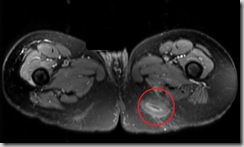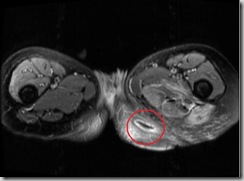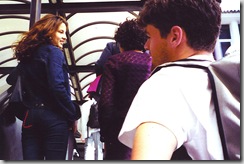Getting A Little Work Done
A girl I briefly dated once told me I had, "No ass." As it turns out, the location of my oft-discussed pressure sore as evidence, I suppose she was right about that. After tomorrow though, in that spot, I will have less. And as a means to an end this will be a good thing.
Hey Hey, My MRI
This is how the pressure sore looked in September of last year. In this cross-sectional image, my legs projecting out towards the viewer, the sore is circled.
The next image is the condition of my sore in April of this year. Not much difference in the appearance, hence the necessity of the third surgery to clear out the last residual infection.
Over the summer I underwent daily hyperbaric oxygen treatments to help aid in healing this sore (and in conjunction watched a lot of shitty movies - I'm looking at you Mission: Impossible 3). While I can't confirm the extent to which these hyperbaric treatments contributed to curing the osteomyelitis that delayed the healing process for these many months, the wound responded to treatment in such a way this summer that the U of M plastic surgery team feels they can safely close my sore with a flap procedure.
Everyone's Favorite Substitute Anatomy Diagram, One More Time
A pressure sore forms because the blood circulation to the tissue covering a bony prominence becomes constricted and the tissue then deteriorates. When it was discussed with me last October that these sores often need to be closed surgically and that this was often accomplished with a flap procedure I was under the assumption this would be something similar to a face lift. An ass lift of sorts. I'm not going to pretend to know all what is involved in a face lift, but I do know that it entails stretching loose skin back to make it appear tighter, more youthful. Simply stretching the skin next to and over the cavity caused by the pressure sore will not rectify the problem of providing more cushioning over the ischial bone where the sore formed in the first place ("No ass," as stated previously). The gluteal rotation flap attempts to solve this problem by moving not only the skin but a portion of the gluteus maximus muscle over the depression caused by the sore. The procedure is more involved than the three debridements and biopsies that were previously performed and is expected to take two to three hours. I'm anticipating to end up with a scar that looks something like this:
The convalescence period after this operation starts with at least three weeks of complete bed rest to allow the flap to take hold. After which point, if the drainage has subsided, I can start a sitting protocol regimen. I will begin with fifteen minutes of sitting three times a day. If there are no problems with bruising or lack of circulation, the sitting durations will be increased by fifteen minutes every couple of days. If all goes according to schedule it will be a six week recovery process.
And then I'll finally be able to get back to whatever it was I was planning to do last fall.

